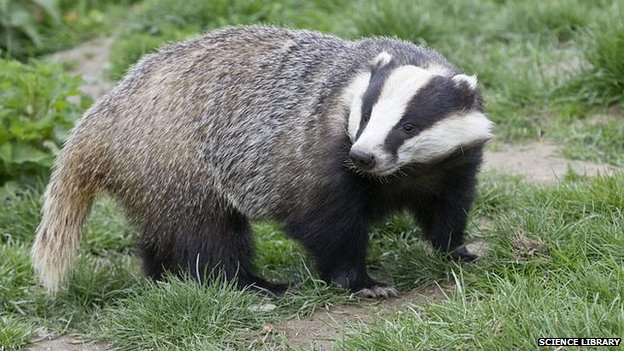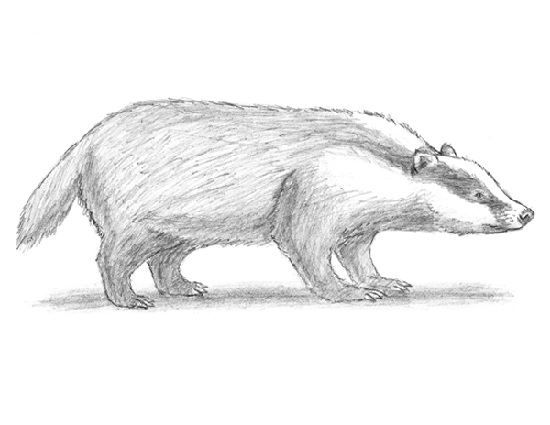


How to Draw a Badger
Please PAUSE the video after each step to draw at your own pace.
For the first few steps, don’t press down too hard with your pencil. Use light, smooth strokes to begin.
Step 1: Draw two circles as guides for the badger’s body. They don’t have to be perfect. They’re just guides. The circle on the left should be a tiny bit bigger than the one on the right, and there should be some space between them.
Step 2: Draw another circle about half the size of the first one on the right side as a guide for the badger’s head.
Step 3: Draw an arc on the right side of the head as a guide for the badger’s muzzle.
Step 4: Draw a smaller, rounder arc on top of the head as a guide for the badger’s ears.
Step 5: Draw two angled lines under the badger’s body (one below each circle) as guides for the legs.
Step 6: Draw a series of curved lines that connect the major shapes to form the body. On the left side of the badger’s body, draw another line as a guide for the tail.
That’s it for the initial sketch! From this point on, press harder with your pencil to get a more defined sketch.
Step 7: Draw the eye about halfway inside the circle on the right side. The eyes are very small and are shaped like a football. Shade the inside of the eye except for a tiny circle to represent glare. Draw a few lines surrounding the badger’s eye for extra detail.
Step 8: Draw the badger’s nose on the tip of the muzzle. Lightly draw a half circle on the front, then darken the shape using quick, short strokes for fur. Draw a thick, curved line inside the left side of the badger’s nose for the nostril.
Step 9: Draw the rest of the muzzle using the arc as a circle. Dip the top of the snout more and use quick, short strokes to draw the badger’s mouth and chin under the nose.
Step 10: Use the smaller arc as a guide to draw the badger’s ears. Use quick, short strokes for a furry look and make them pointier. Draw some fur inside the ears, too, and the other ear on the other side.
Step 11: Use the original circle as a guide to draw the rest of the badger’s head. Use short strokes on top and longer strokes on the bottom to get different lengths of fur.
Step 12: Use the line as a guide to draw the badger’s front legs. Draw lightly at first to get the structure right. When you’re happy with what you have, go ahead and darken it. Badgers have short, powerful legs for digging, so make them thicker on top and draw a few curved lines at the end for the badger’s long claws. Draw the leg on the other side the same way. Notice how only three of the five toes are visible on each leg because of the angle.
Step 13: Use the other line as a guide to draw the hind legs the same way as the front legs. Remember to draw the leg lightly at first, then darken it when you have the structure right. Draw around the guide line and make the leg thicker. Draw a few curved lines at the end for the badger’s claws. Now draw the leg on the other side using the same technique.
Step 14: Use quick, short strokes to darken the remaining lines and form the badger’s body. Use longer strokes on the bottom to represent the longer belly fur.
Step 15: Use the line on the left side as a guide to draw the badger’s tail. Use longer strokes to make it bushier.
Step 16 (optional): You can stop here for a sketchy look or erase as much as you can of the initial guide lines for a cleaner look. Don’t worry about erasing all of them. It’s okay to leave some behind. Also re-draw any final sketch lines that you may have accidentally erased.
Step 17 (optional): Add some shading to your drawing to give it more dimension and volume. Pick the direction of the light source when shading so that the shadows are consistent with it. Vary the pressure on your pencil to get different degrees of tonal value.
Step 18 (optional): Add a cast shadow underneath. This helps ground the badger so it doesn’t appear to be floating.
Step 19 (optional): You can add more value throughout your badger drawing for extra detail. It’s a good idea to use reference to be accurate when adding the fur pattern. You can pause the video if you want to use this drawing as reference for a European badger. The markings are different in other badgers. You also have to make other changes, like shaggier fur for the American badger or a shorter muzzle for the honey badger.


